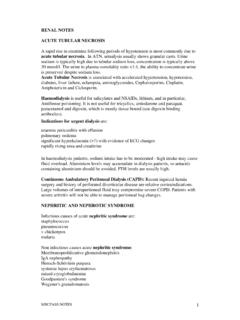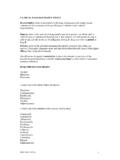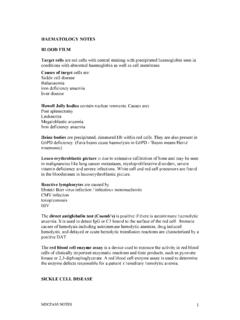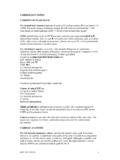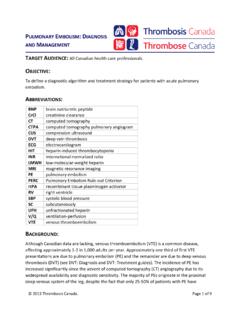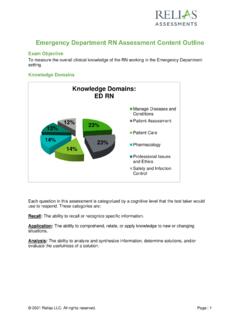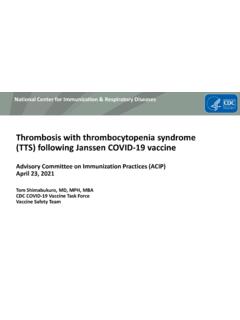Transcription of HAEMATOLOGY NOTES BLOOD FILM - MRCPass.com
1 HAEMATOLOGY NOTES . BLOOD FILM. Target cells are red cells with central staining with precipitated haemoglobin seen in conditions with abnormal haemoglobin as well as cell membrane. Causes of target cells are: Sickle cell disease thalassaemia iron deficiency anaemia liver disease Howell Jolly bodies contain nuclear remnants. Causes are: Post splenectomy Leukaemia Megaloblastic anaemia Iron deficiency anaemia Heinz bodies are precipitated, denatured Hb within red cells. They are also present in G6PD deficiency. (Fava beans cause haemolysis in G6PD - 'Beans means Heinz'.)
2 Mnemonic). Leuco erythroblastic picture is due to extensive infiltration of bone and may be seen in malignancies like lung cancer metastases, myeloproliferative disorders, severe vitamin deficiency and severe infections. White cell and red cell precursors are found in the bloodstream in leucoerythroblastic picture. Reactive lymphocytes are caused by Ebstein Barr virus infection / infectious mononucleosis CMV infection toxoplasmosis HIV. The direct antiglobulin test (Coomb's) is positive if there is autoimmune haemolytic anaemia. It is used to detect IgG or C3 bound to the surface of the red cell.
3 Immune causes of hemolysis including autoimmune hemolytic anemias, drug induced hemolysis, and delayed or acute hemolytic transfusion reactions are characterized by a positive DAT. The red BLOOD cell enzyme assay is a device used to measure the activity in red BLOOD cells of clinically important enzymatic reactions and their products, such as pyruvate kinase or 2,3-diphosphoglycerate. A red BLOOD cell enzyme assay is used to determine the enzyme defects responsible for a patient`s hereditary hemolytic anemia. SICKLE CELL DISEASE. MRCPASS NOTES 1. Sickle cell disease is due to substitution of valine for glutamic acid (position 6 of the beta chain).
4 All forms of sickle cell include HbS. Aseptic necrosis of the hip, cholecystitis, renal papillary necrosis and proliferative retinopathy are clinical features of sickle cell disease. Hb SS patients sickle at 6 kPA hypoxia but SC patients at a lower pO2 of 4 kPa. When there is neurological damage or visceral sequestration crisis in sickle cell crisis, exchange transfusion is indicated. Exchange transfusion involves drawing out the patient's BLOOD while exchanging it for donor red BLOOD cells. It can be done manually or automatically with erythrocytapheresis.
5 The acute chest syndrome in sickle cell disease can be defined as: 1. a new infiltrate on chest x-ray 2. associated with one or more NEW symptoms: fever, cough, sputum production, dyspnea, or hypoxia. The most common cause of aplastic crisis, is parvovirus infection. Patients with sickle cell anemia also exhibit increased susceptibility to other common infectious agents, including Mycoplasma pneumoniae, Staphylococcus aureus, and Escherichia coli. THALASSEMIA. Mutations in globin genes cause thalassemias. Alpha thalassemia affects the alpha- globin gene(s).
6 Beta thalassemia affects one or both of the beta-globin genes. The genetic defect usually is a missense or nonsense mutation in the beta-globin gene (not deletion). thalassemia is caused by mutations of the globin gene on chromosome 11. In beta thalassemia major (ie, homozygous beta thalassemia), the production of beta- globin chains is severely impaired, because both beta-globin genes are mutated. In beta thalassemia major, one of the beta-globin chains is impaired. The severe anemia resulting from this disease, if untreated, can result in high-output cardiac failure, which causes the highest mortality.
7 Iron overload which occurs relatively quickly due to recurrent transfusions, can be reduced with INTRAVENOUS desferrioxamine. The side effects are deafness and retinal damage. HAEMOLYTIC ANAEMIAS. Hereditary spherocytosis gene for ankyrin (cell membrane protein) has been mapped to chromosome 8 and is autosomal dominant. The condition is commoner among Northern Europeans. It presents in childhood with jaundice and splenomegaly. Spherocytes on BLOOD film suggests hereditary spherocytosis (HS). In HS the red cells are smaller, rounder, and more fragile than normal.
8 The osmotic fragility test is MRCPASS NOTES 2. the best diagnostic test, although AGLT (Acidified glycerol lysis test) may be used as a screening tool for relatives. Treatment is with splenectomy. Glucose 6 phosphate dehydrogenase deficiency (X linked recessive) is seen in African, Mediterranean, Iraqi, Jew and South East Asian Chinese people. It predisposes to a haemolytic anaemia reaction to drugs and infection. The BLOOD film in G6PD deficiency shows characteristic blister cells, where the membrane protrudes out like a blister. Drugs causing haemolysis in G6PD deficiency are: Sulphonamides Antimalarials (chloroquine, quinine, primaquine).
9 Antipyretics (aspirin + paracetamol). Chloramphenicol nitrofurantoin Dapsone Probenecid Vit K. OTHER ANAEMIAS. A high MCV with normal folate and B12 levels, normal iron and a BLOOD film showing anisocytosis and poikilocytosis suggests sideroblastic anaemia. Sideroblasts are abnormal red cell precursors with iron loaded mitochondria, forming a ring around the nucleus. In sideroblastic anaemia, there is increased bone marrow iron. This is reflected in the increased iron stores in ferritin and also haemosiderin and ringed premature red BLOOD cells (sideroblasts) due to excess iron.
10 Sideroblastic anaemia is associated with: ALA synthase 2 deficiency Alcohol Lead Myelodysplasia drugs (paracetamol, phenacetin, pyrazinamide and chloramphenicol). In sideroblastic anaemia, there is a defect in haem synthesis (failure to incorporate iron into the haemoglobin molecule). This leads to excess loading of iron to compensate in red cell precursors and into iron stores, sometimes causing haemosiderosis in the liver. Desferrioxamine therapy may help. Aplastic anaemia can be congenital (Fanconi's anaemia) or acquired due to drugs (benzene compounds, insecticides, gold or penicillamine).
